The Effect of Electroslag Remelting on the Microstructure and Mechanical Properties of CrNiMoWMnV Ultrahigh-Strength Steels
Abstract
1. Introduction
2. Materials and Methods
3. Results and Discussion
3.1. Microstructure Characterization
3.2. Volume Fractions, Size, and Frequency of Precipitates
3.3. Effect of ESR on Micro-Segregation
3.4. Mechanical Properties
3.4.1. Changes in the Mechanical Properties of UHSS I
3.4.2. Changes in the Mechanical Properties of UHSS II
3.4.3. Changes in the Mechanical Properties of UHSS III
3.5. Fractography
4. Conclusions
- ESR leads to refinement of the PAGS in all of the investigated steels.
- ESR has almost no effect on the degree of micro-segregation.
- It is not possible to draw general conclusions regarding the effect of ESR on the NMI characteristics, microstructure, and mechanical properties. The effect depends on the impurity level, the starting chemical composition, and the change in chemical composition during ESR, together with the composition of the slag and the details of the subsequent thermomechanical treatment.
- For the fully martensitic steels studied, ESR leads to an increase in the UTS, YS, and hardness. Many microstructural features have been identified that can contribute to the improvement of these properties: Refinement of the PAGS, the effective high-angle grain size, and the lath size, an increase in the number of fine precipitates, and an increase in RA. However, for the fully martensitic steels, the effect of ESR on elongation to fracture, CVN impact toughness, and percentage ductile fracture varies with the steel chemistry.
- For the steel with a mixed martensitic–bainitic microstructure, the changes in chemical composition brought about by ESR led to an increase in the volume fraction of bainite, which lowered the UTS and YS, but enhanced the elongation to fracture, the CVN impact toughness, and the percentage ductile fracture.
- The reduction in the size and incidence of NMIs brought about by ESR leads to a reduction in the incidence of large microvoids on the ductile fracture surfaces of room temperature tensile test specimens.
Author Contributions
Funding
Acknowledgments
Conflicts of Interest
References
- Gladman, T. The Physical Metallurgy of Microalloyed Steels; Institute of Materials: London, UK, 1997. [Google Scholar]
- Bhattacharya, A.; Singh, P.M. Effect of Heat Treatment on Corrosion and Stress Corrosion Cracking of S32205 Duplex Stainless Steel in Caustic Solution. Metall. Mater. Trans. A 2009, 40, 1388–1399. [Google Scholar] [CrossRef]
- Maity, S.K.; Rajak, A.K.; Chandra Shekhar, M.; Singh, S.D. Development of 0.2 C-CrMnMoV Ultra High Strength Steel. Int. J. Sci. Eng. Technol. 2014, 3, 101–108. [Google Scholar]
- Maity, S.K.; Ballal, N.B.; Goldhahn, G.; Kawalla, R. Development of Ultrahigh Strength Low Alloy Steel through Electroslag Refining Process. ISIJ Int. 2009, 49, 902–910. [Google Scholar] [CrossRef]
- Caballero, F.G.; Bhadeshia, H.K.D.H. Very strong bainite. Curr. Opin. Solid State Mater. Sci. 2004, 8, 251–257. [Google Scholar] [CrossRef]
- Garcia-Mateo, C.; Caballero, F.G.; Bhadeshia, H.K.D.H. Development of Hard Bainite. ISIJ Int. 2003, 43, 1238–1243. [Google Scholar] [CrossRef]
- Yokota, T.; García Mateo, C.; Bhadeshia, H.K.D.H. Formation of nanostructured steels by phase transformation. Scr. Mater. 2004, 51, 767–770. [Google Scholar] [CrossRef]
- Kennett, S.C.; Findley, K.O. Strengthening and toughening mechanisms in martensitic steel. Adv. Mater. Res. 2014, 922, 350–355. [Google Scholar] [CrossRef]
- Morito, S.; Tanaka, H.; Konishi, R.; Furuhara, T.; Maki, T. The morphology and crystallography of lath martensite in Fe-C alloys. Acta Mater. 2003, 51, 1789–1799. [Google Scholar] [CrossRef]
- Kitahara, H.; Ueji, R.; Tsuji, N.; Minamino, Y. Crystallographic features of lath martensite in low-carbon steel. Acta Mater. 2006, 54, 1279–1288. [Google Scholar] [CrossRef]
- Zhang, L.P.; Davis, C.L.; Strangwood, M. Effect of TiN particles and microstructure on fracture toughness in simulated heat-affected zones of a structural steel. Metall. Mater. Trans. A 1999, 30, 2089–2096. [Google Scholar] [CrossRef]
- Wang, C.; Wang, M.; Shi, J.; Hui, W.; Dong, H. Effect of microstructure refinement on the strength and toughness of low alloy martensitic steel. J. Mater. Sci. Technol. 2007, 23, 659–664. [Google Scholar]
- Orowan, E. Discussion in on Internal Stresses. In Symposium on Internal Stresses in Metals and Alloys; Institute of Metals: London, UK, 1947. [Google Scholar]
- Wang, Q.; Zhang, C.; Li, R.; Gao, J.; Wang, M.; Zhang, F. Characterization of the microstructures and mechanical properties of 25CrMo48V martensitic steel tempered at different times. Mater. Sci. Eng. A 2013, 559, 130–134. [Google Scholar] [CrossRef]
- Vaish, A.K.; Iyer, G.V.R.; De, P.K.; Lakra, B.A.; Chakrabarti, A.K.; Ramachandrarao, P. Electroslag remelting-Its status, mechanism and refining aspects in the production of quality steels. J. Metall. Mater. Sci. 2000, 42, 11–29. [Google Scholar]
- Duckworth, W.E.; Hoyle, G. Electroslag Refining; Chapman and Hall: London, UK, 1969. [Google Scholar]
- Biebricher, U.; Scholz, H. Electro slag remelting technologies in the past and in the future. Plant Technol. Int. (Germany) 1998, 22, 36–38. [Google Scholar]
- Zhu, Q.; Li, J.; Shi, C.; Yu, W. Effect of electroslag remelting on carbides in 8Cr13MoV martensitic stainless steel. Int. J. Miner. Metall. Mater. 2015, 22, 1149–1156. [Google Scholar] [CrossRef]
- Ali, M.; Porter, D.; Kömi, J.; Heikkinen, E.P.; Eissa, M.; El, F.; Mattar, T. The effect of electroslag remelting on the cleanliness of CrNiMoWMnV ultrahigh-strength steels. J. Min. Metall. Sect. B 2019, 55, 381–395. [Google Scholar] [CrossRef]
- Ali, M.; Eissa, M.; El Faramawy, H.; Porter, D.; Kömi, J.; El-Shahat, M.F.; Mattar, T. Electroslag Refining of CrNiMoWMnV Ultrahigh-Strength Steel. J. Miner. Mater. Charact. Eng. 2017, 5, 385. [Google Scholar] [CrossRef]
- Meng, F.G.; Dong, J.X.; Zhang, M.C. Comparison of microstructure characteristics of different smelting process in 028 alloy for oil pipes. Mater. Res. Innov. 2014, 18, S4-301–S4-308. [Google Scholar] [CrossRef]
- Wang, C.; Wang, M.; Shi, J.; Hui, W.; Dong, H. Effect of microstructural refinement on the toughness of low carbon martensitic steel. Scr. Mater. 2008, 58, 492–495. [Google Scholar] [CrossRef]
- Apple, C.A.; Caron, R.N.; Krauss, G. Packet microstructure in Fe-0.2 pct C martensite. Metall. Trans. 1974, 5, 593–599. [Google Scholar] [CrossRef]
- Krauss, G. Martensite in steel: Strength and structure. Mater. Sci. Eng. A 1999, 273–275, 40–57. [Google Scholar] [CrossRef]
- Zakerinia, H.; Kermanpur, A.; Najafizadeh, A. Color metallography; a suitable method for characterization of martensite and bainite in multiphase steels. Int. J. Iron Steel Soc. Iran 2009, 6, 14–18. [Google Scholar]
- Dyson, D.J.; Holmes, B. Effect of alloying additions on the lattice parameter of austenite. J. Iron Steel Inst. 1970, 208, 469–474. [Google Scholar]
- Schillé, J.-P.; Guo, Z.; Saunders, N.; Miodownik, A.P. Modeling phase transformations and material properties critical to processing simulation of steels. Mater. Manuf. Processes 2011, 26, 137–143. [Google Scholar] [CrossRef]
- Zhao, Z.; Liu, C.; Liu, Y.; Northwood, D.O. A new empirical formula for the bainite upper temperature limit of steel. J. Mater. Sci. 2001, 36, 5045–5056. [Google Scholar] [CrossRef]
- Bleck, W.; Kechagias, E.; Ohlert, J.; Christen, J.L.; Moulin, A.; Haidemenopoulos, G.; Vasilakos, A.; Katsamas, A.; Papatriantafyllou, G.; Aaravas, N. Optimisation of Microstructure in Multiphase steels containing retained austenite. EUR 2004, 21131, 1–199. [Google Scholar]
- De Cooman, B.C. Structure–properties relationship in TRIP steels containing carbide-free bainite. Curr. Opin. Solid State Mater. Sci. 2004, 8, 285–303. [Google Scholar] [CrossRef]
- Traint, S.; Pichler, A.; Hauzenberger, K.; Stiaszny, P.; Werner, E. Influence of silicon, aluminium, phosphorus and copper on the phase transformations of low alloyed TRIP-steels. Steel Res. Int. 2002, 73, 259–266. [Google Scholar] [CrossRef]
- Papaefthymiou, S.; Bleck, W.; Kruijver, S.; Sietsma, J. Influence of intercritical deformation on microstructure of TRIP steels containing Al. Mater. Sci. Technol. 2004, 20, 201. [Google Scholar]
- Arh, B.; Podgornik, B.; Burja, J. Electroslag remelting: A process overview. Mater. Sci. Technol. 2016, 50, 971–979. [Google Scholar] [CrossRef]
- Kawalla, R. Development of ultrahigh strength steel by electroslag refining: Effect of inoculation of titanium on the microstructures and mechanical properties. ISIJ Int. 2006, 46, 1361–1370. [Google Scholar]
- Zhou, T.; Yu, H.; Wang, S. Effect of microstructural types on toughness and microstructural optimization of ultra-heavy steel plate: EBSD analysis and microscopic fracture mechanism. Mater. Sci. Eng. A 2016, 658, 150–158. [Google Scholar] [CrossRef]
- Man, J.; Yang, Y.T.; Shao, G.J. The Microstructure and Elements Distribution of High-Chiromium Hypereatectoid Steel by High-Temperature Homogenization. Available online: https://www.scientific.net/AMR.652-654.975 (accessed on 11 May 2018).
- D’Souza, N.; Lekstrom, M.; Dong, H.B. An analysis of measurement of solute segregation in Ni-base superalloys using X-ray spectroscopy. Mater. Sci. Eng. A 2008, 490, 258–265. [Google Scholar]
- Wang, M.; Zha, X.; Gao, M.; Ma, Y.; Liu, K.; Li, Y. Structure, Microsegregation, and Precipitates of an Alloy 690 ESR Ingot in Industrial Scale. Metall. Mater. Trans. A 2015, 46, 5217–5231. [Google Scholar] [CrossRef]
- Miettinen, J.; Louhenkilpi, S.; Kytönen, H.; Laine, J. IDS: Thermodynamic–kinetic–empirical tool for modelling of solidification, microstructure and material properties. Math. Comput. Simul. 2010, 80, 1536–1550. [Google Scholar] [CrossRef]
- Simm, T.; Sun, L.; McAdam, S.; Hill, P.; Rawson, M.; Perkins, K. The Influence of Lath, Block and Prior Austenite Grain (PAG) Size on the Tensile, Creep and Fatigue Properties of Novel Maraging Steel. Materials 2017, 10, 730. [Google Scholar] [CrossRef]
- Roebuck, B.; Phatak, C.; Birks-Agnew, I. A Comparison of the Linear Intercept and Equivalent Circle Methods for Grain Size Measurement in WC/Co Hardmetals; NPL Report: Middlesex, UK, 2004. [Google Scholar]
- Mandal, G.; Roy, C.; Ghosh, S.K.; Chatterjee, S. Structure-property relationship in a 2 GPa grade micro-alloyed ultrahigh strength steel. J. Alloys Compd. 2017, 705, 817–827. [Google Scholar] [CrossRef]
- Morito, S.; Nishikawa, J.; Maki, T. Dislocation density within lath martensite in Fe-C and Fe-Ni alloys. ISIJ Int. 2003, 43, 1475–1477. [Google Scholar] [CrossRef]
- Hansen, N.; Huang, X. Microstructure and flow stress of polycrystals and single crystals. Acta Mater. 1998, 46, 1827–1836. [Google Scholar] [CrossRef]
- Haynes, A.G.; Steven, W. The temperature of formation of martensite and bainite in low-alloy steel. J. Iron Steel Inst. 1956, 183, 349–359. [Google Scholar]
- Sun, X.; Li, Z.; Yong, Q.; Yang, Z.; Dong, H.; Weng, Y. Third generation high strength low alloy steels with improved toughness. Sci. China Technol. Sci. 2012, 55, 1797–1805. [Google Scholar] [CrossRef]
- Lan, H.F.; Du, L.X.; Li, Q.; Qiu, C.L.; Li, J.P.; Misra, R.D.K. Improvement of strength-toughness combination in austempered low carbon bainitic steel: The key role of refining prior austenite grain size. J. Alloys Compd. 2017, 710, 702–710. [Google Scholar] [CrossRef]
- Hutchinson, B.; Hagström, J.; Karlsson, O.; Lindell, D.; Tornberg, M.; Lindberg, F.; Thuvander, M. Microstructures and hardness of as-quenched martensites (0.1–0.5%C). Acta Mater. 2011, 59, 5845–5858. [Google Scholar] [CrossRef]
- Xie, X.S.; Zeng, Y.P. The effect of inclusions on mechanical behaviour in ultra-high strength alloy steels. Mater. Sci. Forum 2010, 654, 51–56. [Google Scholar] [CrossRef]
- Cox, T.B.; Low, J.R. An investigation of the plastic fracture of AISI 4340 and 18 Nickel-200 grade maraging steels. Metall. Trans. 1974, 5, 1457–1470. [Google Scholar] [CrossRef]
- Zhou, Q.; Qian, L.; Tan, J.; Meng, J.; Zhang, F. Inconsistent effects of mechanical stability of retained austenite on ductility and toughness of transformation-induced plasticity steels. Mater. Sci. Eng. A 2013, 578, 370–376. [Google Scholar] [CrossRef]
- Tu, M.-Y.; Hsu, C.-A.; Wang, W.-H.; Hsu, Y.-F. Comparison of microstructure and mechanical behavior of lower bainite and tempered martensite in JIS SK5 steel. Mater. Chem. Phys. 2008, 107, 418–425. [Google Scholar] [CrossRef]



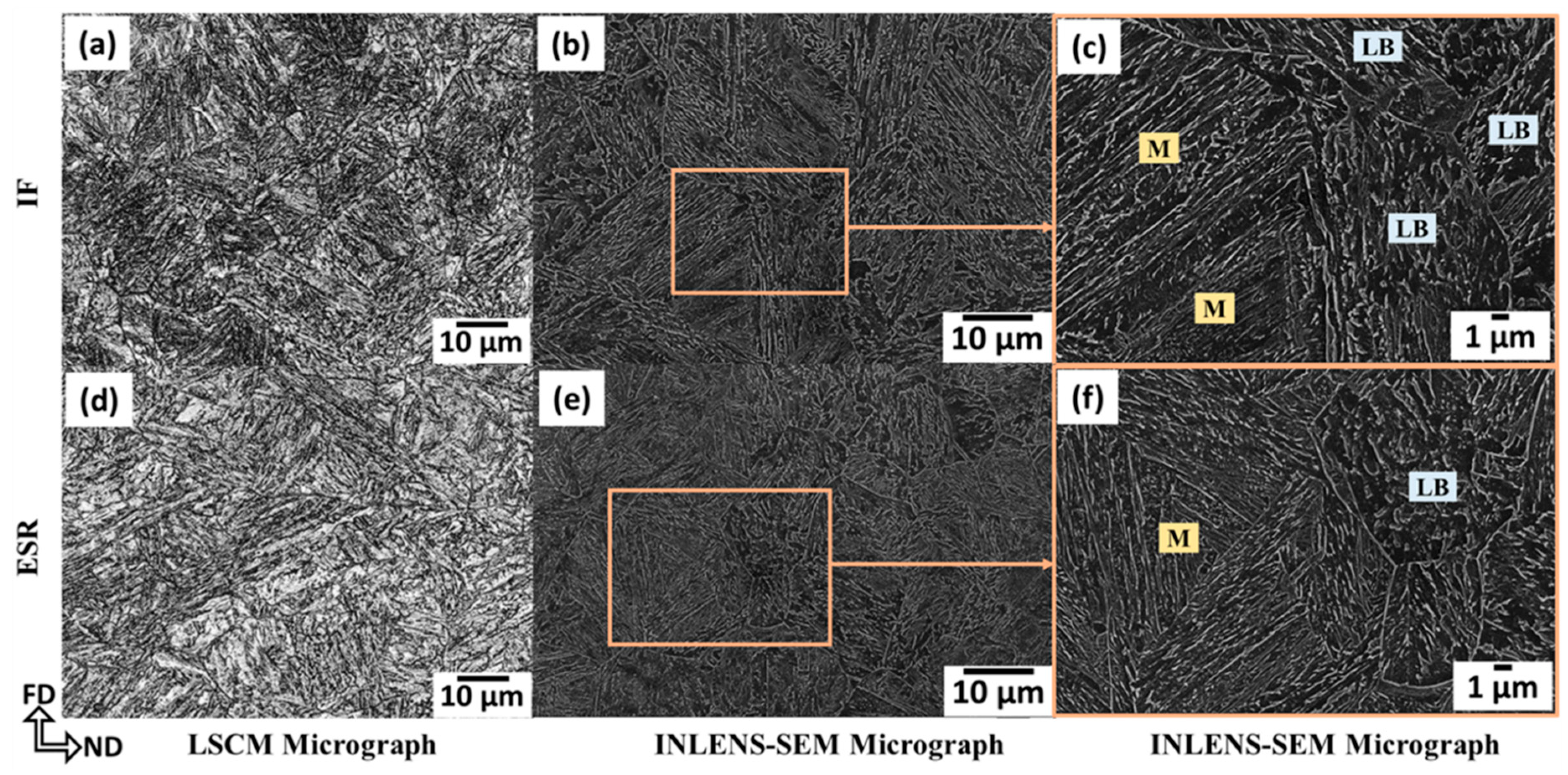

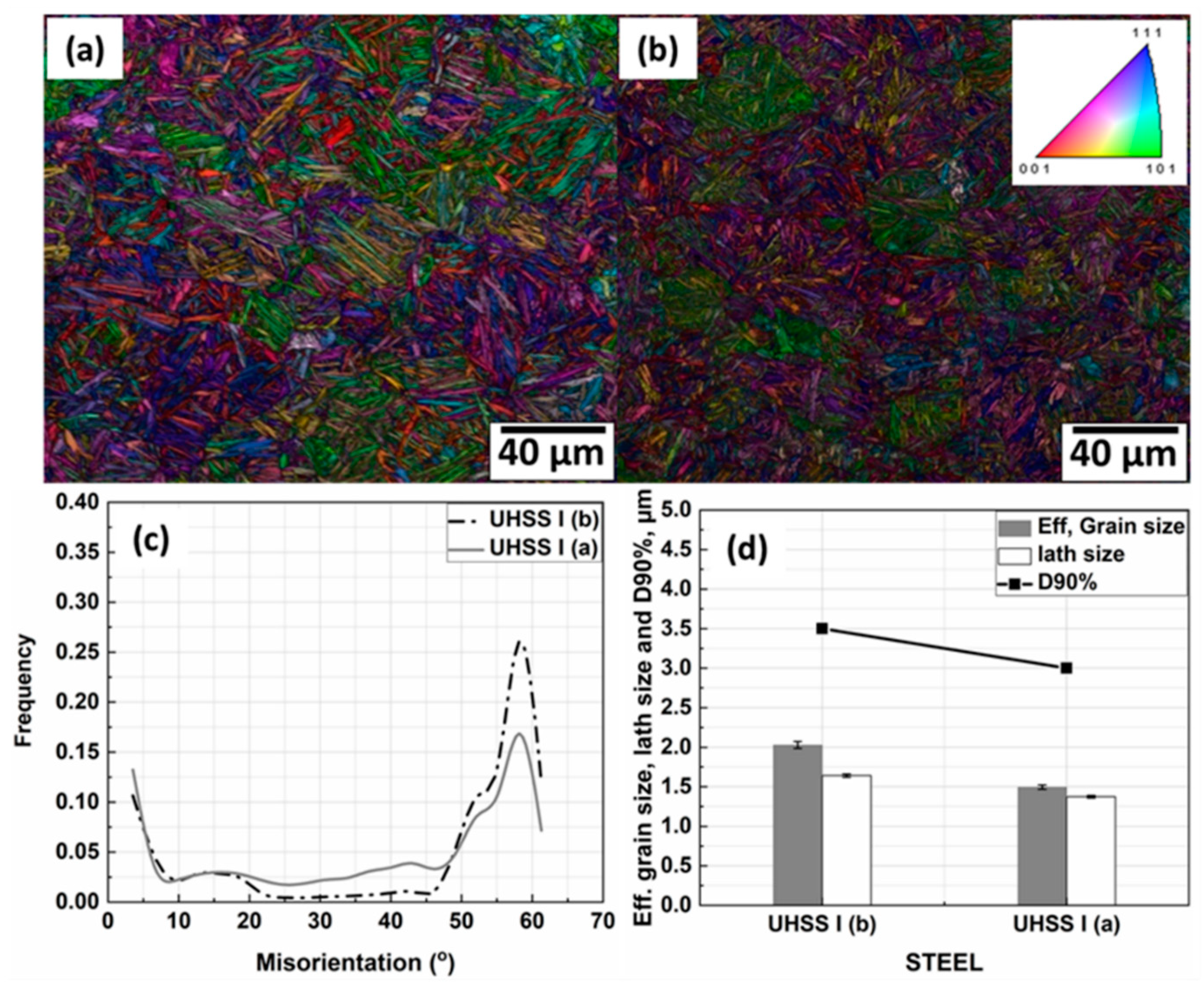

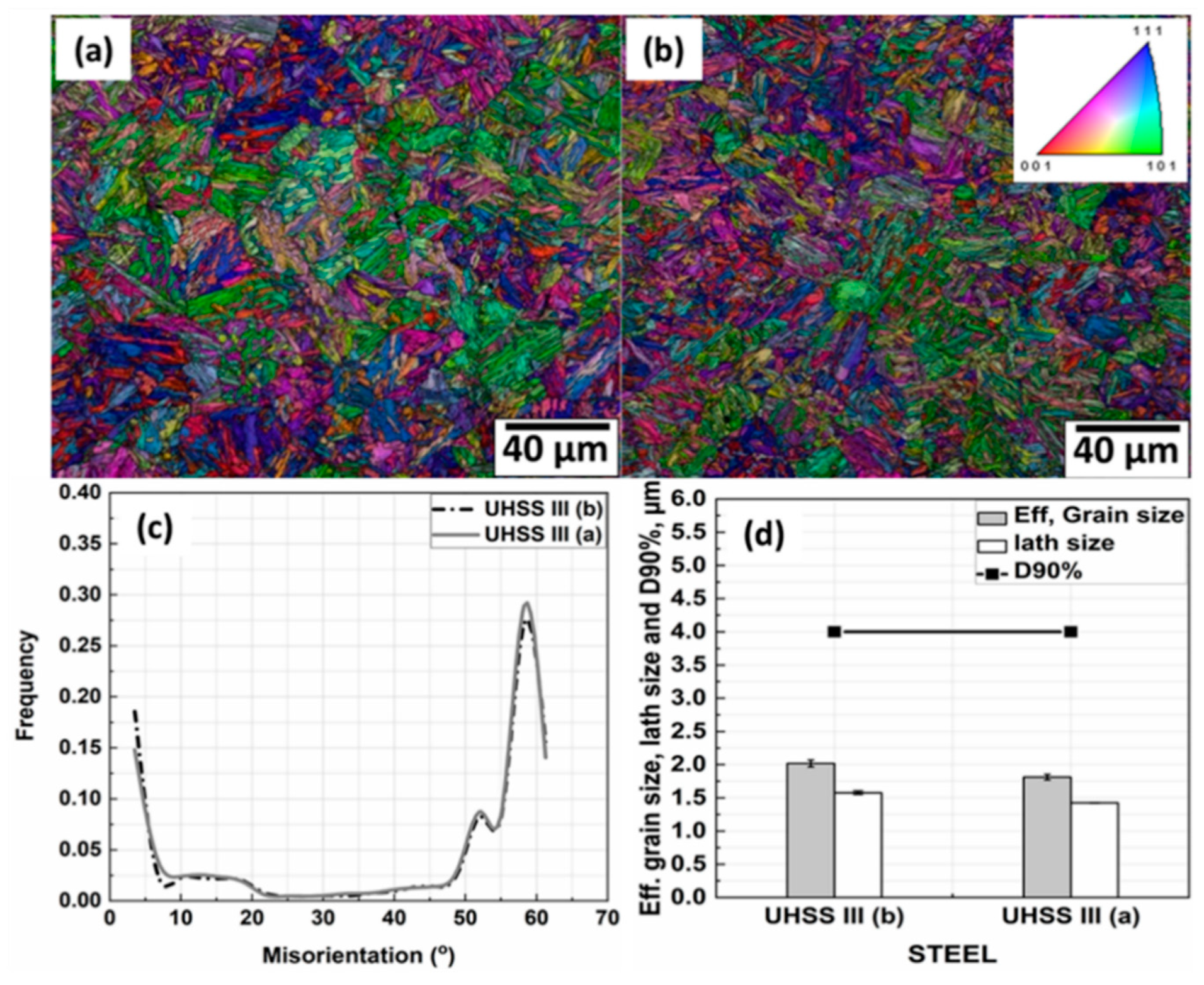
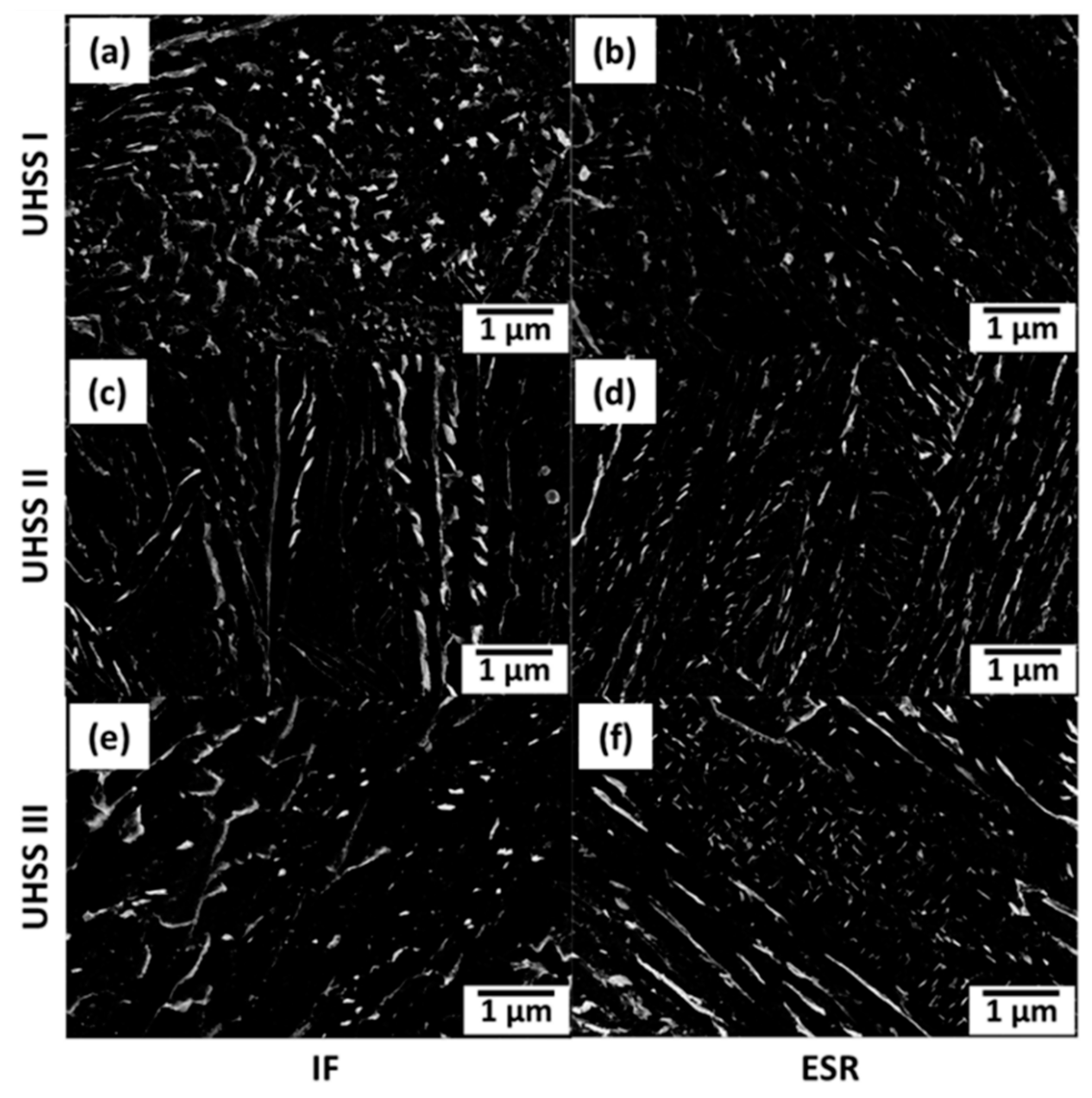

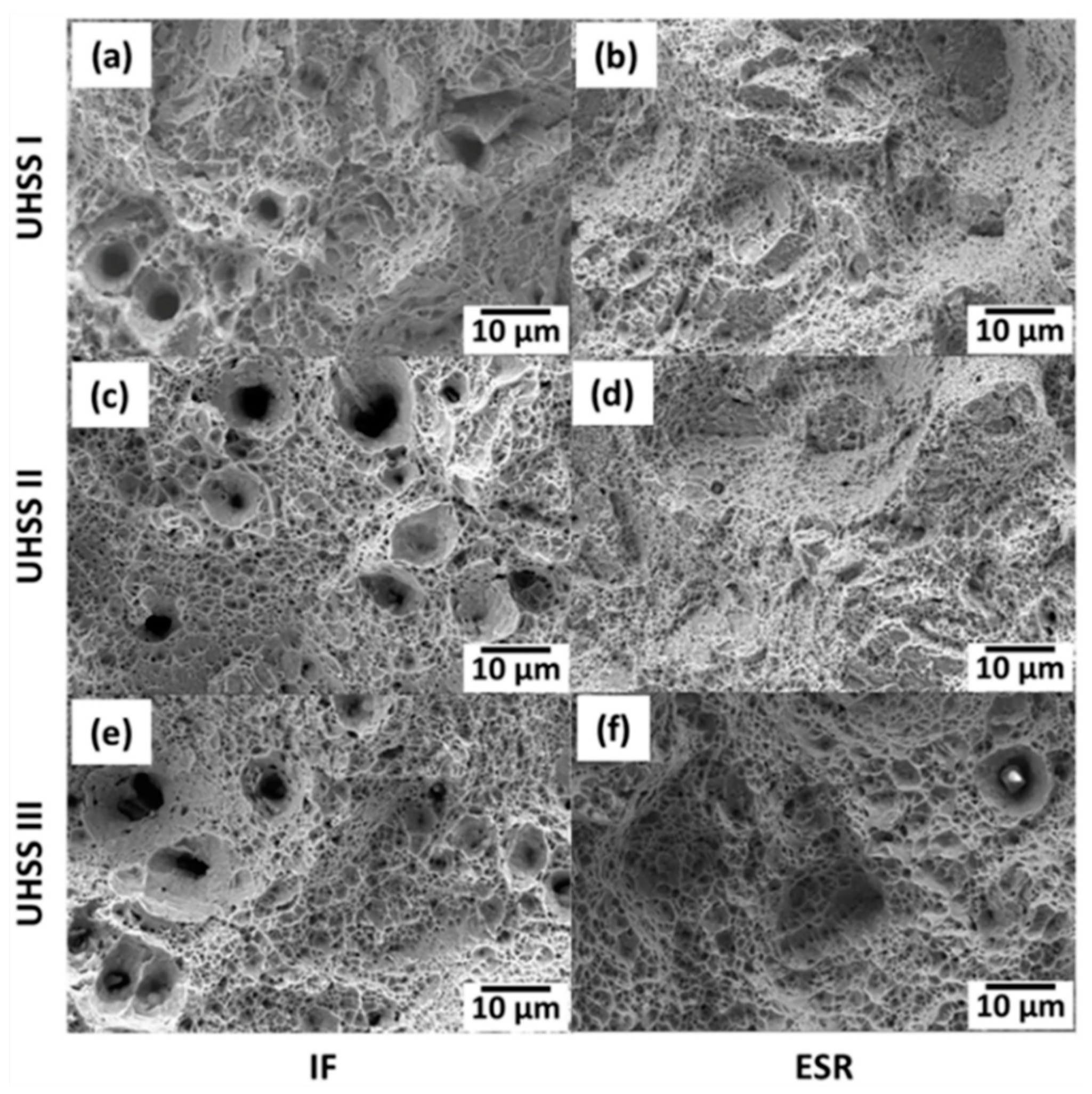
| Heat No. | Process | Chemical Composition, wt.% | |||||||||||||||
|---|---|---|---|---|---|---|---|---|---|---|---|---|---|---|---|---|---|
| C | Cr | Ni | Mo | W | Mn | Si | V | Ti | Nb | Cu | Al | P | S | N | O | ||
| UHSS I | IF | 0.30 | 2.32 | 2.34 | 0.32 | 1.21 | 0.70 | 0.71 | 0.075 | 0.001 | 0.001 | 0.017 | 0.009 | 0.019 | 0.024 | 0.013 | 0.014 |
| ESR | 0.32 | 2.18 | 2.31 | 0.31 | 1.14 | 0.64 | 0.64 | 0.072 | 0.001 | 0.001 | 0.020 | 0.060 | 0.018 | 0.013 | 0.011 | 0.004 | |
| UHSS II | IF | 0.25 | 2.40 | 2.49 | 0.32 | 1.34 | 0.57 | 0.90 | 0.087 | 0.002 | 0.001 | 0.018 | 0.009 | 0.019 | 0.025 | 0.020 | 0.011 |
| ESR | 0.29 | 2.37 | 2.45 | 0.33 | 1.23 | 0.53 | 0.81 | 0.085 | 0.003 | 0.001 | 0.020 | 0.058 | 0.019 | 0.014 | 0.018 | 0.007 | |
| UHSS III | IF | 0.15 | 1.73 | 4.44 | 0.31 | 1.33 | 0.41 | 0.51 | 0.067 | 0.002 | 0.002 | 0.016 | 0.009 | 0.018 | 0.022 | 0.022 | 0.012 |
| ESR | 0.18 | 1.65 | 4.35 | 0.32 | 1.24 | 0.35 | 0.31 | 0.062 | 0.001 | 0.001 | 0.020 | 0.043 | 0.018 | 0.017 | 0.015 | 0.006 | |
| Heat No. | Process | Vol. Fraction of RA, % 1 | Mean % C in RA (Cγ) | Mean PAGS, µm 2 |
|---|---|---|---|---|
| UHSS I | IF | 5.2 ± 0.3 | 0.7 | 25 ± 2.8 |
| ESR | 6.5 ± 0.1 | 0.4 | 13 ± 1.7 | |
| UHSS II | IF | 8.1 ± 0.2 | 1.2 | 27 ± 3.2 |
| ESR | 6.6 ± 0.1 | 0.4 | 13 ± 2.1 | |
| UHSS III | IF | 7.1 ± 0.2 | 0.8 | 23 ± 2.7 |
| ESR | 5.6 ± 0.8 | 0.8 | 22 ± 3.1 |
| Steel | Process | Vol. Fraction of Bainite, % | Vol. Fraction of Martensite, % | Vol. Fraction of RA, % | Bainite Start Temperature (Bs), °C | Martensite Start Temperature (Ms), °C |
|---|---|---|---|---|---|---|
| UHSS I | IF | 0 | 99 | 1 | 388 | 280 |
| ESR | 4 | 95 | 1 | 397 | 279 | |
| UHSS II | IF | 0 | 99 | 1 | 384 | 292 |
| ESR | 1 | 98 | 1 | 382 | 284 | |
| UHSS III | IF | 8 | 91 | 1 | 426 | 313 |
| ESR | 24 | 75 | 1 | 438 | 314 |
| Steel | Process | Volume Fraction of Precipitates (f), % | Number of Precipitates per Total Investigated Area, 588 µm2 | Average Size, nm | D95%, nm | Max. Size, nm |
|---|---|---|---|---|---|---|
| UHSS I | IF | 0.37 | 1742 (3/µm2) | 49 ± 0.53 | 120 | 381 |
| ESR | 0.39 | 2239 (4/µm2) | 44 ± 0.41 | 110 | 321 | |
| UHSS II | IF | 0.41 | 1333 (2/µm2) | 59 ± 0.94 | 170 | 532 |
| ESR | 0.58 | 2078 (4/µm2) | 56 ± 0.61 | 140 | 498 | |
| UHSS III | IF | 0.31 | 1108 (2/µm2) | 56 ± 1.00 | 150 | 565 |
| ESR | 0.45 | 1555 (3/µm2) | 54 ± 0.82 | 140 | 541 |
| Steel | Temperature, °C | Precipitates | Solvus Temperature, °C | Volume Fractions of Each Precipitates at Given Temperature, % | Total Volume Fractions at Given Temperature, % |
|---|---|---|---|---|---|
| UHSS I (IF) | 950 | AlN | 1022 | 0.0100 | 0.064 |
| VN | 1064 | 0.0539 | |||
| 750 | AlN | 1022 | 0.0250 | 2.417 | |
| Ti(N,C) | 793 | 0.0003 | |||
| VN | 1064 | 0.1100 | |||
| M23C6 [(Cr,Fe)20 (Mo,W)3 (C)6] | 803 | 2.2820 | |||
| UHSS I (ESR) | 950 | AlN | 1186 | 0.0703 | 0.072 |
| TiN | 1270 | 0.0020 | |||
| 750 | AlN | 1186 | 0.0750 | 2.373 | |
| VC | 900 | 0.1240 | |||
| M23C6 [(Cr,Fe)20 (Mo,W)3 (C)6] | 800 | 2.1744 | |||
| UHSS II (IF) | 950 | AlN | 1048 | 0.0140 | 0.106 |
| VN | 1120 | 0.0920 | |||
| 750 | AlN | 1048 | 0.0280 | 2.196 | |
| V(N,C) | 1120 | 0.1350 | |||
| Ti(N,C) | 804 | 0.0006 | |||
| M23C6 [(Cr,Fe)20 (Mo,W)3 (C)6] | 781 | 2.0320 | |||
| UHSS II (ESR) | 950 | AlN | 1224 | 0.1130 | 0.119 |
| TiN | 1396 | 0.0060 | |||
| 750 | AlN | 1224 | 0.1180 | 2.732 | |
| TiN | 1396 | 0.0040 | |||
| VC | 915 | 0.1400 | |||
| M23C6 [(Cr,Fe)20 (Mo,W)3 (C)6] | 797 | 2.4700 | |||
| UHSS III (IF) | 950 | AlN | 1069 | 0.0190 | 0.092 |
| TiN | 1396 | 0.0730 | |||
| 750 | AlN | 1069 | 0.0310 | 0.143 | |
| TiN | 1396 | 0.1120 | |||
| UHSS III (ESR) | 950 | AlN | 1178 | 0.0910 | 0.093 |
| TiN | 1305 | 0.0020 | |||
| 750 | AlN | 1178 | 0.1000 | 0.170 | |
| TiN | 1305 | 0.0010 | |||
| V(C,N) | 853 | 0.0690 |
| Steel | Process | Si | Cr | W | Mo | Ni | Mn | V |
|---|---|---|---|---|---|---|---|---|
| UHSS I | IDS Calc. | 0.8 | 0.7 | NA | 0.3 | 1.0 | 0.8 | 0.4 |
| IF | 0.8 | 0.6 | 1.0 | 0.4 | 0.9 | 0.8 | 0.4 | |
| ESR | 0.8 | 0.6 | 0.8 | 0.4 | 1.0 | 0.7 | 0.5 | |
| UHSS II | IDS Calc. | 1.1 | 0.6 | NA | 0.2 | 0.9 | 1.4 | 0.2 |
| IF | 0.7 | 0.6 | 1.0 | 0.4 | 0.9 | 0.8 | 0.3 | |
| ESR | 0.7 | 0.7 | 0.8 | 0.5 | 1.0 | 0.7 | 0.5 | |
| UHSS III | IDS Calc. | 0.8 | 0.7 | NA | 0.3 | 0.9 | 0.8 | 0.4 |
| IF | 0.7 | 0.6 | 1.0 | 0.5 | 1.0 | 0.8 | 0.5 | |
| ESR | 0.7 | 0.7 | 1.0 | 0.6 | 1.0 | 0.8 | 0.4 |
| Steel | Process | Tensile Properties | Charpy V Test at Room Temperature | Hardness | ||||
|---|---|---|---|---|---|---|---|---|
| Rm, MPa | Rp0.2, MPa | A, % | Absorbed Energy, J | Ductile 1 Fracture% | HV10 | Calculated Hardness for Full Martensite 2 | ||
| UHSS I | IF | 1872 ± 14.63 | 1145 ± 23.07 | 12 ± 1.33 | 24 ± 0.5 | 30 | 548 ± 6 | 558 |
| ESR | 1978 ± 32.70 | 1277 ± 14.14 | 14 ± 0.15 | 25 ± 0.5 | 34 | 595 ± 5 | 576 | |
| UHSS II | IF | 1729 ± 6.82 | 1153 ± 17.14 | 18 ± 0.16 | 36 ± 0.5 | 59 | 532 ± 10 | 514 |
| ESR | 2007 ± 7.74 | 1216 ± 17.20 | 14 ± 0.25 | 27 ± 1 | 30 | 562 ± 13 | 549 | |
| UHSS III | IF | 1353 ± 9.06 | 921 ± 5.47 | 19 ± 0.58 | 53 ± 3.5 | 69 | 411 ± 4 | 426 |
| ESR | 1265 ± 13.08 | 831 ± 19.99 | 21 ± 0.52 | 67 ± 2.5 | 72 | 386 ± 3 | 452 | |
| Steel | Process | σL, MPa | Increment due to ESR, MPa | σp, MPa | Increment due to ESR, MPa | Dislocation | Increment due to ESR, MPa | |
|---|---|---|---|---|---|---|---|---|
| Density, m−2 | σD, MPa | |||||||
| UHSS I | IF | 54 | 23 | 84 | 1 | 1.75 × 1015 | 201 | 4 |
| ESR | 78 | 85 | 1.82 × 1015 | 205 | ||||
| UHSS II | IF | 72 | 66 | 90 | 16 | 1.58 × 1015 | 190 | 9 |
| ESR | 137 | 106 | 1.72 × 1015 | 199 | ||||
| UHSS III | IF | 59 | 13 | 78 | 15 | 1.23 × 1015 | 168 | 7 |
| ESR | 72 | 93 | 1.33 × 1015 | 175 | ||||
| Steel | Process | Lath Size (ECD), µm | Lath Size (MLI), µm |
|---|---|---|---|
| UHSS I | IF | 1.64 | 2.12 |
| ESR | 1.37 | 1.48 | |
| UHSS II | IF | 1.43 | 1.60 |
| ESR | 1.03 | 0.84 | |
| UHSS III | IF | 1.58 | 1.95 |
| ESR | 1.42 | 1.59 |
© 2020 by the authors. Licensee MDPI, Basel, Switzerland. This article is an open access article distributed under the terms and conditions of the Creative Commons Attribution (CC BY) license (http://creativecommons.org/licenses/by/4.0/).
Share and Cite
Ali, M.; Porter, D.; Kömi, J.; Eissa, M.; El Faramawy, H.; Mattar, T. The Effect of Electroslag Remelting on the Microstructure and Mechanical Properties of CrNiMoWMnV Ultrahigh-Strength Steels. Metals 2020, 10, 262. https://doi.org/10.3390/met10020262
Ali M, Porter D, Kömi J, Eissa M, El Faramawy H, Mattar T. The Effect of Electroslag Remelting on the Microstructure and Mechanical Properties of CrNiMoWMnV Ultrahigh-Strength Steels. Metals. 2020; 10(2):262. https://doi.org/10.3390/met10020262
Chicago/Turabian StyleAli, Mohammed, David Porter, Jukka Kömi, Mamdouh Eissa, Hoda El Faramawy, and Taha Mattar. 2020. "The Effect of Electroslag Remelting on the Microstructure and Mechanical Properties of CrNiMoWMnV Ultrahigh-Strength Steels" Metals 10, no. 2: 262. https://doi.org/10.3390/met10020262
APA StyleAli, M., Porter, D., Kömi, J., Eissa, M., El Faramawy, H., & Mattar, T. (2020). The Effect of Electroslag Remelting on the Microstructure and Mechanical Properties of CrNiMoWMnV Ultrahigh-Strength Steels. Metals, 10(2), 262. https://doi.org/10.3390/met10020262





